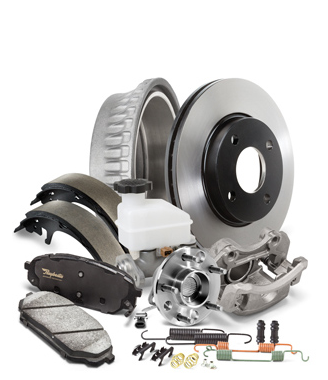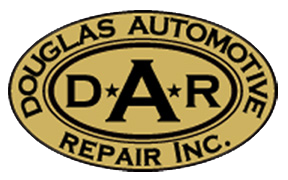There’s no room for second best when it comes to your brakes. Douglas Automotive Repair’s expert technicians inspect your vehicle’s braking system to assure safe, smooth driving. Do you ever wonder about what makes your vehicle stop when you push down the brake pedal? We’ve put together some information about the different types of brake systems and how they work.
Any brake work at Douglas Automotive Repair always starts with an inspection of the braking components on your vehicle.
Disc Brakes
- Disc brake rotors and pads
- Calipers and hardware
Drum Brakes
- Brake drums and shoes
- Wheel cylinders
- Return springs
Parking Brake
Cables
Hydraulic System
- Master cylinder
- Brake fluid and hose

Power Booster
The brake system equipped in your vehicle is a culmination of over 100 years of technological innovation. While brake systems vary by make and model, the basic system consists of disc brakes in front and either disc or drum brakes in the rear. Connected by a series of tubes and hoses, your brakes are linked to each wheel and the master cylinder by said network, which supply them with vital brake fluid (hydraulic fluid).
We’ll take a closer look at how this works, but first we’ll provide a brief overview of the critical components that make braking possible. We can summarize all of your braking equipment into two categories:
Hydraulics
Master Cylinder: When it comes to your vehicle, think of the master cylinder as a pressure converter. When you press down on the brake pedal (physical pressure), the master cylinder converts this to hydraulic pressure. This pressure is used to propel brake fluid to the wheel brakes.
Brake Lines and Hoses: Steel braided brake lines and high pressure, shock, and road resistant brake hoses are the channels which deliver pressurized brake fluid to the braking unit(s) at each wheel.
Wheel Cylinders and Calipers: Wheel cylinders consist of cylinders surrounded by two rubber-sealed pistons that connect the piston with the brake shoe. When brake pressure is applied, pistons are forced out, pushing the shoes into the drum. Calipers squeeze brake pads onto the rotor to stop your car. Both components apply pressure to friction materials.
Friction Materials
Disc Brake Pad and Drum Brake Shoes: A disk brake uses fluid (released by the master cylinder) to force pressure into a caliper, where it presses against a piston. The piston then squeezes two brake pads against the rotor, forcing it to stop. Brake shoes consist of a steel shoe with friction material bonded to it.
How it Comes Together: When you first step on the brake pedal, you are triggering the release of brake fluid into the system of tubes and hoses, which travel to the braking unit at each wheel. This is because you actually push against a plunger in the master cylinder, causing the fluid to be released. Now because brake fluid can’t be compressed, it journeys through the network of tubes and hoses in the exact same motion and pressure it initially began with. When it comes to a stopping a 2,000 pound vehicle at high speed, this consistency is a good thing! But the performance of your brakes can be affected when air is introduced into the fluid, since air can compress, it creates sponginess in the pedal, which disrupts the consistency, and results in bad braking efficiency. The good news is that the “bleeder screws” (located at each wheel cylinder) can be removed so that the brake system is “bled” to remove any unwanted air found in your system.
On every Douglas Automotive Repair brake job, we clean and lube all caliper pins and slides to make sure all parts are operating freely. This helps to prolong the pad life. For brake shoes, we also clean and lubricate backing plates and self adjusters, again, to help prolong the life of the brake shoes.
We use only quality parts, and in many cases we use either original equipment (OE) parts, or parts made by manufacturers of OE parts. Call us today, or visit our website to use our convenient on-line scheduling form to schedule your brake inspection.This entry was posted in Brakes and tagged Brakes on August 4, 2015.
